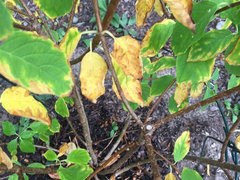The Single Strategy To Use For Hydrangea Leaves Turning Yellow
Wiki Article
Hydrangea Leaves Turning Yellow Things To Know Before You Get This
Table of ContentsHydrangea Leaves Turning Yellow for BeginnersHydrangea Leaves Turning Yellow - An Overview6 Easy Facts About Hydrangea Leaves Turning Yellow Explained9 Simple Techniques For Hydrangea Leaves Turning YellowFacts About Hydrangea Leaves Turning Yellow Uncovered
Huge fallen leaves commonly look sagging throughout the afternoon warm. When they stop working to perk up in the evening or still look wilted in the morning, your plant could be overwatered.Remove the plant from the dirt and trim out any kind of roots that aren't white and swollen (plump). Replant in a brand-new location or work some sand right into the dirt for much better drainage. Underwatering also creates leaves to turn yellow with brown, crunchy edges. Do not attempt to remedy the issue by sprinkling excessively.
Photosynthesis, as we all understand, is crucial for plant survival, so chlorosis needs to be dealt with rapidly. While chlorosis can be brought on by other nutrient deficiencies, it is most commonly an iron deficiency. In the following area you will certainly find out exactly how to recognise whether your plant has an iron shortage or another thing.
First shows up on the older fallen leaves, however the leaf veins continue to be green. While there is typically enough iron in all-natural soil, hydrangeas typically battle to take in enough of it.
The 30-Second Trick For Hydrangea Leaves Turning Yellow
The most effective means to avoid iron deficiency-chlorosis in hydrangeas is to plant them in suitable ericaceous or acidic dirt. When growing in a bed, mix in some peat or reduced-peat ericaceous compost and inspect the p, H worth yearly. This is required due to the fact that the compost blend around the plants will certainly affect the p, H worth of the soil over time and the p, H worth may rise again.
It is just made use of on a business range, where an extended iron deficiency would certainly imply substantial return losses. The special fertilizers for this are often costly and need to be applied in really exact dosages to avoid damages to the fallen leaves. Foliar fertilisation is only reliable for a short period and needs to be used frequently or supplemented by typical iron fertilisation.
September is the finest time of year to do something concerning those hydrangeas. Their fallen leaves are transforming yellow, the blossoms have faded, and their gangly look is making you crazy.
Now to deal with the staying hedge, not a rather view as winter months strategies. Mophead, Lacecap and Oakleaf hydrangeas grow on old timber. What that indicates is they will certainly bloom next year on timber that was created this year. Do not trim Mophead, Lacecaps and Oakleaf hydrangeas to the ground, as you will eliminate the stems that prepare to bloom following springtime.
The Main Principles Of Hydrangea Leaves Turning Yellow
That means you won't be eliminating also many of following year's flower buds. If the bush is getting larger than you like, you can take out a 3rd of the real-time wood while you're in there.We're ideal use this link in the center of our late-blooming hydrangea period below, so I assumed I 'd share an idea for this certain kind of hydrangea that I discovered really fascinating. A whole lot of people have a similar concern with their panicle hydrangeas where they start to see the fallen leaves transforming yellow and handing over at different components of the period and it can be pretty remarkable and quite worrying due to the fact that it can happen actually quickly on a hedge that appears like it's or else truly healthy.

my link Where we reside in area 6, they're fairly simple to have success with and they're actually preferred in our area, which is great because that implies that there are hydrangeas simply concerning everywhere currently of year. When you see your hydrangea leaves starting to turn yellow, you might assume that your plant is passing away or being maltreated in some method, but actually, the reverse is real.
Everything about Hydrangea Leaves Turning Yellow
If you truly intend to make best use of blossoms, a (the center number) will truly assist increase the number and size of your blooms. You need to see the number of newly-yellowed fallen leaves lower pretty rapidly as quickly as you give your hydrangea the food it requires. Hydrangea Leaves Turning Yellow. The bright side is that if you do absolutely nothing, the plant will certainly still be great, it will certainly simply have a few much less fallen leavesCourtenay is the author of guide The Cleaning Ninja and has been included in various magazines consisting of Country Sampler Farmhouse Style, Better Residences and Gardens, Parents Magazine, Real Simple, and Our Residences.
Waterlogged soil deprives the roots of oxygen, causing root rot and yellow fallen leaves. On the other hand, underwatering or dehydration triggers the plant to shrivel and its foliage to yellow. Preserving a consistent watering schedule and making certain correct drain with water drainage holes or layers can assist stop these problems.
Recommended Reading With correct treatment and maintenance, hydrangeas can prosper and keep their vivid, colorful leaves. Hydrangea leaves transforming yellow is a typical concern that can be attributed to various factors.
Hydrangea Leaves Turning Yellow Can Be Fun For Everyone

Report this wiki page